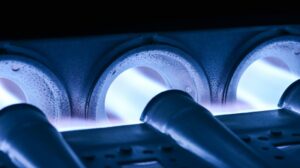
If we were to guess what kind of heater you use in your home to stay comfortable during our chilly winters, it’s probably safe to guess it’s a natural gas furnace. After all, these are the most popular heaters throughout the country, and their popularity is highest in states with weather systems like ours. Natural gas is a cost-efficient fuel source–more so than electricity. Since most households also have ductwork running through, furnaces are also a bit more popular than boilers.
Today’s modern furnaces are designed with safety in mind, and will operate even more safely if you make sure you stay on top of your annual professional tune-ups.
But it’s important to remember that even the most well-cared-for gas furnace has the potential to suffer from gas leaks and combustion hazards that require quick, professional repair. The biggest repair concern is a cracked heat exchanger. Ignoring this problem can lead to a significant safety hazard in your home. Read on to learn more!
What Is a Heat Exchanger?
Of course, our team can’t expect our customers to take a cracked heat exchanger seriously if you don’t even know what a heat exchanger is! Basically, it’s the component within the gas furnace that applies heat to the air that the blower fan sends through the ventilation system. It’s a metal chamber, or a series of metal chambers, designed in a clamshell fashion, where hot combustion gases from the burners collect.
The intense heat from the gas raises the temperature of the metal walls, which makes the outside of the heat exchanger very hot. Air coming from the blower fan blows around the heat exchanger and picks up the heat coming off of it. This enables your furnace to actually apply the heat of the combustion gases, without letting those gases come into contact with the air entering your living space.
How Do Heat Exchangers Crack?
The heat exchangers in a furnace undergo a large amount of stress. Every time one heats up, the metal expands. Over time, this consistent expansion and contraction can weaken the metal, eventually causing corrosion. This is especially true if the gas isn’t well vented out of the flue. Corrosion weakens metal, creating small fissures or cracks along the heat exchanger.
Why a Cracked Heat Exchanger Is Bad News
Cracks along the heat exchanger may look harmless–actually you wouldn’t be able to see them at all because they’re so small. But what happens is that these cracks widen when the heat exchanger expands from the intense heat, and this allows unhealthy gases that are supposed to be vented into the flue instead to go right into the air traveling to the living spaces. Carbon monoxide (CO) leaks are often traced back to cracked furnace heat exchangers and lead to hundreds of illnesses and even fatalities every year.
It’s important to keep up on maintenance to avoid this problem. A cracked heat exchanger is more likely in an older furnace–10-15 years, but keeping up on maintenance every year, no matter how new your furnace is, can help you avoid this problem or catch it early enough so it doesn’t become an actual hazard.
For professional and reliable furnace repair in Colorado Springs, CO, contact Brown’s Heating & Cooling.
